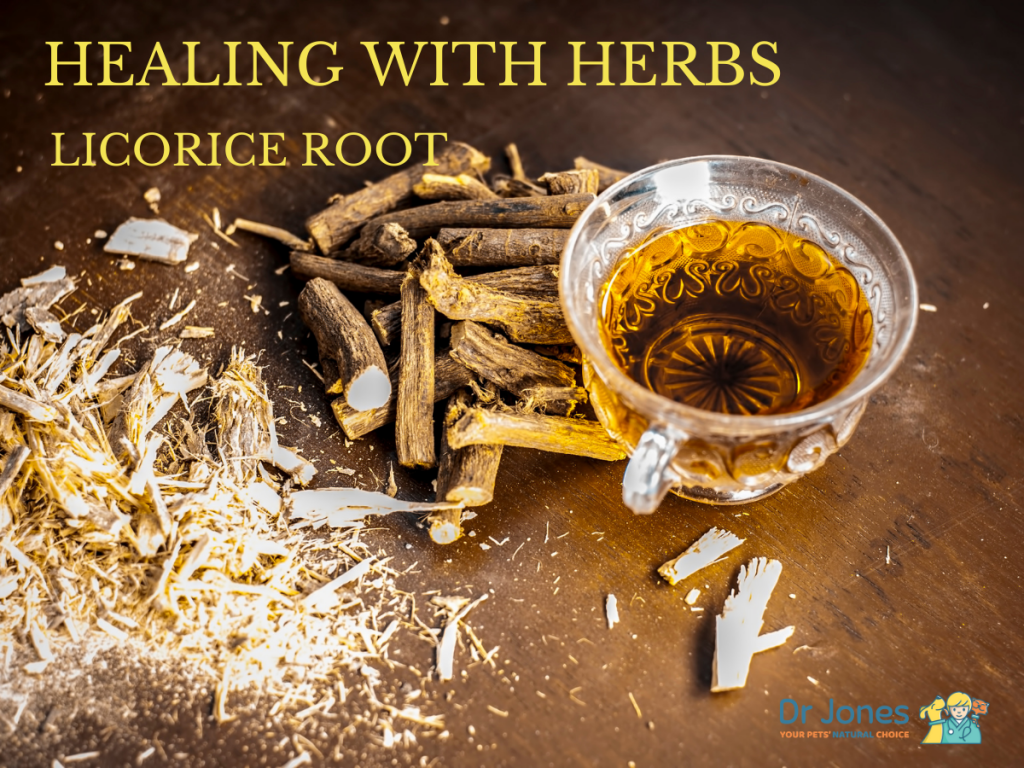Healing With Herbs: Licorice Root

Welcome to part one of a four-part series dedicated to highlighting some of my favourite herbs to incorporate into your pets’ regimen – today we are covering Licorice Root.
History of Licorice Root
Licorice Root, or glycyrrhiza glabra, is a root natively grown in southern Europe, Egypt, China and India. It is a member of the legume family.
Historical figures such as King Tut, Julius Caesar, and Napoleon were known to use it for a variety of respiratory and gastrointestinal issues – Napoleon reportedly ate it so often his teeth turned black from the juices.
In Chinese medicine, anti-inflammatory licorice root has been used for centuries for many of the same uses that science has confirmed now:
- Sore Throats
- Coughs
- Gastric Pain and Ulcers
As well, it’s been used Indian Ayurvedic medicine for:
- Poisonings
- Viral Respiratory Tract Infections
- Hepatitis
- Wounds from operations
While it’s modern uses are mainly in candies, it is still a wonderful natural option to incorporate into your pets diets for a variety of purposes.
Glycyrrhizin and Side Effects
Glycyrrhizin, is the active ingredient within the licorice root. It is also very sweet – 30-50 times sweeter than sugar, and commonly used in candies.
However, there are adverse effects to taking Licorice Root, and is recommended to be used carefully in some health issues such as:
- Heart Failure
- Heart Disease
- Fluid Retention
- High Blood Pressure
- Diabetes
- Kidney Disease
- Liver Disease
As well, do not use it for more than 14 days at a time. Use cautiously if taking thiazide diuretics, cortisone or cardiac glycosides. Licorice prolongs the half-life of cortisone. Do not use during pregnancy.
Uses of Licorice Root
1. Allergies: Glycyrrhizin is a glycoside that acts as a natural corticosteroid, but without the adverse effects of weakening the immune system. Licorice enhances the body’s anti-inflammatory processes, meaning it’s helpful alongside with more conventional treatments like hydrocortisone therapy.
Dosage: 1/2 ml of tincture/20lbs of body weight twice daily for 14 days maximum
2. Cough and Sore Throat Remedy: One of licorice root’s most well-known uses is to ease congestion from coughs and colds. It acts as an expectorant, helping to loosen and expel phlegm, and it also has a soothing effect on irritated mucous membranes.
Dosage: 1 ml of licorice and 1 tsp of honey
3. Topical Anti-Itch Treatment
- 1 ml of Licorice Root Tincture,
- 1 tbsp of Coconut Oil
- 5 drops of Lavender Oil
Apply topical to affected area twice a day for 7-14 days.
4. Relieve Stomach Ulcers, Digestive Support: Licorice has antibacterial properties and is found to help relieve stomach ulcers, as well as being beneficial for digestion, and it helps soothe irritation and inflammation of the digestive tract.
It is approved for treating painful spasms associated with chronic gastritis by the German Standard License, and in France, licorice root may be used to treat bloating, impaired digestion and gas.
5. Anti-Inflammatory and Immune System Support: Licorice has broad-spectrum anti-viral activity and may be effective against herpes, HIV, hepatitis, SARS and influenza.
If your pet has a cough, I would have you consider the tincture. For pets with skin disorders, I advise the cream. And as an antiviral agent, or for decreasing the ongoing itching of a dog with allergies, you can add the tea daily to your pet’s water.
Dosage and Administration
Deglycyrrhizinated Licorice Extract (DGL): DGL contains no glycyrrhizin, and is a safer option as it has a lowered risk of interactions with medication, and can be safer for longer-term use. Dosage: 0.1 grams per 10lbs – three times daily to treat intestinal issues; also in chewable tablet form.
Tincture: 1 drop per lb. – 0.3ml for a cat, up to 3ml for a large dog three times per day.
Tea: Brew up the dried root with 1 teaspoon of dried root per cup of water, and dose 1/2 cup of brewed tea per 10lbs daily.
Please watch my video with more information on how I use Licorice Root!
I believe I had a side effect of too much licorice. I was indeed enjoying (over a period of weeks)a bunch of organic licorice powder I had bought. Then my feet began to swell .
I looked into it and found it causes potassium deficiency.
So, I then figured that when I was using a lot of licorice, I would be sure to take a good amount of supplemental potassium.
Would giving a cat supplemental potassium enable it to take licorice longer term than 14 days?
Thank you.
How would licorice help my dog with IBD?
Licorice Root and Gastrointestinal Disorders – Acid Reflux, IBD:
Tied to systemic health issues, leaky gut syndrome/IBD can be difficult to tackle. As an anti-inflammatory and demulcent (soothing) herb, licorice root works as a natural remedy for ulcers and can be a beneficial leaky gut supplement. Also studied and effective for Acid Reflux; the type used for the study was DGL licorice, which left participants without any negative side effects associated with glycyrrhizin.
I have a 56lb dog with tummy troubles. Using the sparse info online regarding DGL dosing, I figure it will be safe to give her half of a 320mg DGL tablet, TID. Did I calculate it correctly?
Your calculation of administering half of a 320 mg Deglycyrrhizinated Licorice (DGL) tablet three times daily to your 56 lb dog is approximately correct.
Dr. Andrew Jones recommends a dosage of 0.1 grams (100 mg) of DGL per 10 lbs of body weight, administered three times daily. For your 56 lb dog, this equates to approximately 168 mg per dose, totaling around 504 mg daily. Therefore, giving half of a 320 mg tablet (160 mg) three times daily would provide 480 mg daily, which is close to the recommended amount.